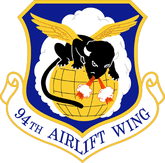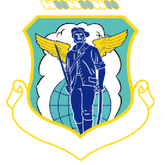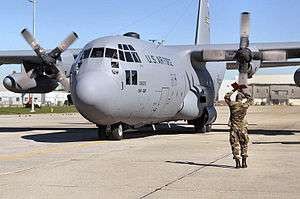94th Airlift Wing
94th Airlift Wing
 | |
|---|---|
|
A member of the 94th Airlift Control Flight marshals a Lockheed C-130H Hercules after a training mission at Dobbins Air Reserve Base | |
| Active | 1949–1951; 1952–present |
| Country |
|
| Branch |
|
| Type | Wing |
| Role | Airlift |
| Size | 1,660 personnel[1] |
| Part of | Air Force Reserve Command |
| Garrison/HQ | Dobbins Air Reserve Base, Georgia. |
| Decorations |
Air Force Outstanding Unit Award Republic of Vietnam Gallantry Cross with Palm |
| Commanders | |
| Current commander | Colonel Steven B. Parker |
| Insignia | |
| 94th Airlift Wing emblem (approved 6 April 1956)[2][note 1] |
 |
| 94th Troop Carrier Wing emblem (approved 19 May 1959)[3] |
 |
| Tail Stripe | Blue, "Dobbins" in Yellow |
| Aircraft flown | |
| Transport | C-130 Hercules |
The 94th Airlift Wing is an Air Reserve Component of the United States Air Force. It is assigned to the Twenty-Second Air Force, Air Force Reserve Command, stationed at Dobbins Air Reserve Base, Georgia.
If activated, Air Education and Training Command, Air Mobility Command, Air Combat Command, and Air Force Reserve Command would each gain separate elements of the wing.
The 94th Airlift Wing is the host organization at Dobbins Air Reserve Base and is responsible for providing security, civil engineering, fire protection, air traffic control, and numerous other services the base and to tenant organizations assigned to the base. This includes the maintenance of the airfield.
Mission
The mission of the 94th Airlift Wing is to train "Citizen Airmen" to execute reliable Lockheed C-130 Hercules operations. To accomplish this, the wing recruits, organizes and trains Air Force Reservists for active duty in time of war, national emergency or contingency tasking. The wing's aircrew use the C-130H aircraft to perform aeromedical evacuation missions and to deliver cargo and personnel to locations ranging from dirt runways to international airports. Flight crews also deliver paratroopers and equipment by airdrop during combat.[1]
Units
The 94th Airlift Wing is organized into a headquarters element, three groups, and a medical element containing 12 squadrons [sic] and 1 flight.[1][note 2]
94th Operations Group
The 94th Operations Group is responsible for aerial delivery operations, aeromedical evacuation, operations support and flying squadron activities, a deployable airlift control flight, airfield management, base weather, and air traffic control. The mission involves tactical combat airland and airdrop of personnel and equipment and forward deployed austere operational command and control of airlift support forces. Its units can deploy anywhere in the world in the event of heightened tension, outbreak of hostilities or to support humanitarian mission as dictated by the National Command Authority.[4] Group subordinate units are:
- 700th Airlift Squadron
- 94th Operations Support Squadron
- 94th Airlift Control Flight[1]
94th Maintenance Group
The 94th Maintenance Group includes military and civilian members providing logistics support and maintenance for the wing’s fleet of C-130H aircraft.[5] Group subordinate units are:
- 94th Maintenance Squadron
- 94th Aircraft Maintenance Flight
- 94th Maintenance Operations Flight[1]
94th Mission Support Group
The 94th Mission Support Group operates and manages the Dobbins Air Reserve Base infrastructure. Included in this mission are "base security, computer-communications, utility services, environmental management, military and civilian personnel, information management, base services, lodging, recreation, food service, facility construction/maintenance, disaster preparedness, bioenvironmental engineering, fire protection and airfield maintenance."[6] Dobbins shares runway access with Naval Air Station Atlanta and Lockheed Martin Aeronautical Systems Company.[6] Group subordinate units are:
- 80th Aerial Port Squadron
- 94th Aerial Port Squadron
- 94th Civil Engineer Squadron
- 94th Communications Squadron
- 94th Force Support Squadron
- 94th Logistics Readiness Squadron
- 94th Mission Support Squadron
- 94th Security Forces Squadron[1]
- 94th Aeromedical Staging Squadron[1]
History
- For related history, see 94th Operations Group
Bombardment and reconnaissance operations
First activated in June 1949 at Marietta Air Force Base as the 94th Bombardment Wing, the wing trained in the reserve as a light bomber wing unitl March 1951, when it was called to active service on 10 March 1951 during the Korean War. By 20 March all wing personnel had been transferred to other USAF organizations and the wing was inactivated on 1 April.[2] The wing's aircraft were also distributed to other organizations [7]
The wing was reactivated in the reserves in June 1952 at what was now called Dobbins Air Force Base[8] as the 94th Tactical Reconnaissance Wing, replacing the 902d Reserve Training Wing. The reserve mobilization for the Korean war had left the reserve without aircraft, and the unit did not receive aircraft until July. Once it received aircraft, it began to train for the reconnaissance mission with a variety of aircraft.[2][8][9]
The Air Force desired that all reserve units be designed to augment the regular forces in the event of a national emergency. The reserves, however, had six pilot training wings with no mobilization mission. On 18 May 1955, they were discontinued.[10] In the resulting reorganization of reserve wings, the 94th Wing transferred its mission, personnel and equipment at Dobbins to the 482d Fighter-Bomber Wing and moved on paper to Scott Air Force Base, Illinois, where it absorbed the resources of the 8711th Pilot Training Wing and returned to its original role as a light bombardment unit.[2][11]
Airlift operations
It flew its Douglas B-26 Invaders for only two years at Scott. The Joint Chiefs of Staff were pressuring the Air Force to provide more wartime airlift. At the same time, about 150 Fairchild C-119 Flying Boxcars became available from the active force. Consequently, in November 1956 the Air Force directed Continental Air Command to convert three reserve fighter bomber wings to the troop carrier mission by 1957. Cuts in the budget in 1957 also led to a reduction in the number of reserve wings from 24 to 15.[12] As a result, reserve flying operations at Scott were reduced to a single squadron (the 73d Troop Carrier Squadron),[11] and the wing moved on paper to Laurence G. Hanscom Field, Massachusetts in November 1957. On arrival at Hanscom, it absorbed the resources of the inactivating 89th Fighter-Bomber Wing[13] and began conversion to Flying Boxcars. By 1958, wing personnel began taking part in regular airlift missions and exercises, both in the United States and overseas[2]
In April 1959, the wing reorganized under the Dual Deputy system. Its 94th Troop Carrier Group was inactivated and the 731st and 732d Troop Carrier Squadrons were assigned directly to the wing.[2][14] Although the 731st was located with the wing at Hanscom,[15] the 732d was stationed at Grenier Field, New Hampshire[16] under he Detached Squadron Concept, a program designed to lessen community impact and facilitate recruiting and manning by locating reserve squadron sized units in smaller population centers, rather than concentrating an entire wing in one location.[17]
Activation of groups under the wing
Although the dispersal of flying units was not a problem when the entire wing was called to active service, mobilizing a single flying squadron and elements to support it proved difficult. This weakness was demonstrated in the partial mobilization of reserve units during the Berlin Crisis of 1961 To resolve this, at the start of 1962, Continental Air Command determined to reorganize its reserve wings by establishing groups with support elements for each of its troop carrier squadrons. This reorganization would facilitate mobilization of elements of wings in various combinations when needed. However, as this plan was entering its implementation phase, another partial mobilization, which included the 94th Wing, occurred for the Cuban missile crisis, with the units being released on 22 November 1962. The formation of troop carrier groups was delayed until February for wings that had been mobilized.[18]
The wing also participated in contingency operations in the Dominican Republic in 1965.[2]
The 902d Group at Grenier was inactivated in January 1966, when the station was turned over to the New Hampshire Air National Guard, but was replaced by the 905th Troop Carrier Group, which had recently moved to Westover Air Force Base, Massachusetts, in July. The wing's two groups converted to Douglas C-124 Globemaster IIs that year, and traded the "troop carrier" in their names for "military airlift" as the wing became the 94th Military Airlift Wing. The wing flew strategic airlift including troop and cargo-carrying missions to Southeast Asia until 1971, augmenting the airlift resources of Military Airlift Command and Tactical Air Command.[2]
In February 1972, the 905th Group was reassigned to the 459th Military Airlift Wing, leaving the wing with only a single group. In July, it moved back to its original base at Dobbins and became the 94th Tactical Airlift Wing. It was assigned the 908th and 918th Tactical Airlift Groups, flying the de Havilland Canada C-7 Caribou. The wing's primary operations now involved support of Army airborne forces, tactical cargo airlift, and air evacuation missions.[2]
From July 1973 to May 1975, the wing flew missions in Puerto Rico, airdropping 1.2 billion sterile screwworm flies as part of a project to eradicate the screwworm menace to Puerto Rico's livestock. It controlled the 907th Tactical Airlift Group with an aerial spraying mission between 1981 and 1989. In 1981, the 94th became the second largest wing in the Air Force Reserve, flying three different types of transport aircraft. By 1987, it had given up C-7 and C-123 aircraft, retaining only C-130s. In 1990-1991, wing personnel transported passengers and materiel between the United States and Southwest Asia.[2]
Elements of the wing rotated regularly to Panama during the 1980s and 1990s. The wing participated in numerous humanitarian airlift and contingency operations worldwide, especially in the areas of Southwest Asia, Europe, and the Caribbean Sea. In the spring of 1996, wing personnel and aircraft deployed to Europe in support of peacekeeping operations in Bosnia.[2]
Recent operations have been the Haiti invasion preparations; deployment to Ramstein Air Base, Germany for Bosnian airlift support; Somalian aeromedical evacuation; air logistic support from Incirlik Air Base, Turkey; and preparations of hurricane relief supplies. In addition, the wing routinely rotates aircraft/crews to Howard Air Force Base, Panama, for Latin and South American logistic support. On nearly a daily basis, unit personnel fly airlift missions throughout the United States.[4]
Lineage
- Established as the 94th Bombardment Wing, Light on 10 May 1949
- Activated in the reserve on 26 June 1949
- Ordered to active service on 10 March 1951
- Inactivated on 1 April 1951
- Redesignated 94th Tactical Reconnaissance Wing on 26 May 1952
- Activated in the Reserve on 14 June 1952
- Redesignated 94th Bombardment Wing, Tactical on 18 May 1955
- Redesignated 94th Troop Carrier Wing, Medium on 1 July 1957
- Ordered to active service on 28 October 1962
- Relieved from active service on 28 November 1962
- Redesignated 94th Military Airlift Wing on 1 October 1966
- Redesignated 94th Tactical Airlift Wing on 1 July 1972
- Redesignated 94th Airlift Wing on 1 February 1992[2]
Assignments
|
|
Components
Groups
- 94th Bombardment Group (later 94th Tactical Reconnaissance Group, 94th Bombardment Group, 94th Troop Carrier Group, 94th Operations Group): 26 June 1949 – 20 March 1951; 14 June 1952 – 14 April 1959; 1 August 1992 – present
- 901st Troop Carrier Group (later 901st Military Airlift Group): 11 February 1963 – 1 July 1972
- 902d Troop Carrier Group: 11 February 1963 – 25 January 1966
- 905th Military Airlift Group: 1 July 1966 – 25 February 1972
- 906th Tactical Airlift Group: 1 April 1981 – 1 July 1982
- 907th Tactical Airlift Group: 1 April 1981 – 1 October 1989
- 908th Tactical Airlift Group: 1 July 1972 – 1 August 1992
- 910th Tactical Airlift Group (later 910th Airlift Group: 1 October 1989 – 1 August 1992
- 911th Tactical Airlift Group: attached 1 – 20 April 1971, assigned 21 April 1971 – 25 February 1972; 1 August 1992 – 1 October 1994
- 914th Tactical Airlift Group (later 914th Airlift Group): 1 January 1964 – 1 July 1966; 1 August 1992 – 1 October 1994
- 918th Tactical Airlift Group 1 July 1972 – 1 September 1975[2]
Squadrons
- 700th Tactical Airlift Squadron (later 700th Airlift Squadron): 1 September 1975 – 1 August 1992
- 731st Troop Carrier Squadron: 14 April 1959 – 11 February 1963
- 732d Troop Carrier Squadron: 14 April 1959 – 11 February 1963[2]
Stations
- Marietta Air Force Base (later Dobbins Air Force Base), Georgia, 26 June 1949 – 1 April 1951
- Dobbins Air Force Base, Georgia, 14 June 1952
- Scott Air Force Base, Illinois, 18 May 1955
- Laurence G. Hanscom Field, Massachusetts, 16 November 1957
- Dobbins Air Force Base (later Dobbins Air Reserve Base), Georgia, 1 July 1972 – present[2]
Aircraft
- North American T-6 Texan, 1949-1950, 1952-1954
- Beechcraft T-7 Navigator, 1949-1951
- Beechcraft T-11 Kansan, 1949-1951
- Douglas B-26 Invader, 1949–1951; 1953–1955, 1955–1957
- Douglas RB-26 Invader , 1954–1955
- Curtiss C-46 Commando, 1952–1955
- North American F-51 Mustang, 1953–1954
- North American TF-51 Mustang, 1953–1955
- North American T-28 Trojan, 1953-1954
- Beechcraft C-45, 1953–1955
- Lockheed T-33 T-Bird, 1954–1955
- Lockheed F-80 Shooting Star, 1954–1955
- Republic F-84 Thunderjet, 1954–1955
- Douglas C-47 Skytrain, 1955
- Fairchild C-119 Flying Boxcar, 1957–1966
- Fairchild C-123 Provider, 1981-1986
- Douglas C-124 Globemaster II, 1966–1972
- de Havilland Canada C-7 Caribou, 1972–1983
- Lockheed C-130 Hercules, 1981–present[2]
References
Notes
Citations
- 1 2 3 4 5 6 7 "Units: 94th Airlift Wing". 94th Airlift Wing Public Affairs. Retrieved July 8, 2016.
- 1 2 3 4 5 6 7 8 9 10 11 12 13 14 15 16 17 Robertson, Patsy (August 9, 2010). "Factsheet 94 Airlift Wing (AFRC)". Air Force Historical Research Agency. Retrieved July 7, 2016.
- ↑ Ravenstein, pp. 132-133
- 1 2 "Fact Sheet 94th Operations Group". 94th Airlift Wing Public Affairs. February 24, 2006. Retrieved July 8, 2016.
- ↑ "Fact Sheet 94th Maintenance Group". 94th Airlift Wing Public Affairs. February 24, 2006. Retrieved July 8, 2016.
- 1 2 "Fact Sheet 94th Mission Support Group". 94th Airlift Wing Public Affairs. February 24, 2006. Retrieved July 8, 2016.
- ↑ Cantwell, p. 137
- 1 2 Mueller, p. 105
- ↑ Cantwell, p. 139
- ↑ Cantwell, p. 146
- 1 2 Mueller, p. 518
- ↑ Cantwell, pp. 168-169
- ↑ Kane, Robert B. (May 27, 2015). "Factsheet 89 Airlift Wing (AMC)". Air Force Historical Research Agency. Retrieved July 25, 2016.
- ↑ Robertson, Patsy (August 19, 2010). "Factsheet 94 Operations Group (AFRC)". Air Force Historical Research Agency. Retrieved July 25, 2016.
- ↑ Maurer, Combat Squadrons, p. 407
- ↑ Maurer, Combat Squadrons, p. 409
- ↑ Cantwell, pp. 156, 169
- ↑ Cantwell, pp. 189-191
Bibliography
![]() This article incorporates public domain material from the Air Force Historical Research Agency website http://www.afhra.af.mil/.
This article incorporates public domain material from the Air Force Historical Research Agency website http://www.afhra.af.mil/.
- Maurer, Maurer, ed. (1983) [1961]. Air Force Combat Units of World War II (PDF) (reprint ed.). Washington, DC: Office of Air Force History. ISBN 0-912799-02-1. LCCN 61060979.
- Maurer, Maurer, ed. (1982) [1969]. Combat Squadrons of the Air Force, World War II (PDF) (reprint ed.). Washington, DC: Office of Air Force History. ISBN 0-405-12194-6. LCCN 70605402. OCLC 72556.
- Mueller, Robert (1989). Air Force Bases, Vol. I, Active Air Force Bases Within the United States of America on 17 September 1982 (PDF). Washington, DC: Office of Air Force History. ISBN 0-912799-53-6.
- Ravenstein, Charles A. (1984). Air Force Combat Wings, Lineage & Honors Histories 1947-1977 (PDF). Washington, DC: Office of Air Force History. ISBN 0-912799-12-9.
External links
- "Home Page, Dobbins Air Reserve Base". 94th Airlift Wing Public Affairs. Retrieved July 8, 2016.

